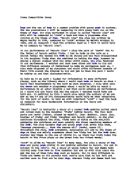Our play consisted of 9 separate characters, Santa; who was the brains behind the situation, we decided it was best to do it this way because young children have many fantasies regarding Santa, Superwoman; the heroine, four elves; the most significant of which being Tweedle Dumb who causes the problem which is the plot, Double and trouble; the two villains in the play and finally Molly; a young child who owns many dolls which come to life. The plot was as follows: The two villains steal all the presents, and the elves with the help of Santa, go on a search for all the presents. Whilst searching they meet Molly, who brings superwoman to life. Superwoman then proceeds to recover all the presents. The main theme in the panto was that thieves never prosper.
A variety of drama skills were used in our play, in the first instance we used a vast amount of role-play. Personally, I needed to evoke evilness in such a way as to keep my character light hearted, as not to frighten the younger audience. We also used a lot of mime whilst in the background, when actors were acting in the foreground. Santa needed to put on a low old voice to evoke the stereotypical Santa. Movement was also important in our pantomime, always making sure we were facing the audience was some times difficult. To work round this problem, any one not in the scene became a director to the other actors; this seemed to work well.
Pantomime has been performed since the middle ages by many actors. The art of pantomime in my view is audience participation; the point of pantomime is to get the audience to be part of the production. Near enough, every pantomime ever performed has contained the phrases “He’s behind you” or “oh yes he is” these are just a few of which people associate with panto. Pantomime is aimed at any age group really. However, our panto was aimed at infant age children, so slight adaptations occurred, such as the type of language, and the basic content. I believe children enjoy panto because there is audience participation. The children enjoy shouting out during their participation, when answering the various characters on stage. I also think they like pantomimes because they feel part of the production, unlike at any other style of performing arts, for example a West London Show like “Starlight Express”. In a way, pantomime can be educational as it shows that good prospers over bad, so it teaches morals. In addition, it demonstrates if you persevere in difficult circumstances, you will prosper. However, on the other side of argument it also illustrates poor aristocracy, as in the upper classes always seem to fail, and the peasants always prosper, but in reality it is not always the case. Overall not everything taught in panto is beneficial, but moralistically it can be.
In conclusion, I was satisfied with our performance, considering we had a very short amount of time to produce the final product. However, some minor details could have been perfected, with a little more concentration at the vital points. Some parts of our play went better in rehearsal than in the final performance, but this can be put down to nerves. If I did the performance again, I would spend more time on preparation. It would also have been beneficial to participate in more rehearsals, as I think everyone would have gained confidence in their individual performances, and in turn there would have been less nervousness. This would perhaps have made the whole production more professional.







